Sometimes, when it comes to hand embroidery, equipment just complicates things. When you think about it, does an embroiderer need a lot of equipment? Not really – needles, a hoop, some sharp scissors, and that about covers the basic needs relating to hand embroidery.
Yet I’ve invested in a new piece of equipment, and although originally I had no intention of writing about it, the Inordinate Infatuation I have with it compels me to write about it.
I’m Excessively Fond of it.
And, more to the point, it’s a Really Handy Piece of Equipment, especially if your primary way of transferring embroidery patterns is by tracing.
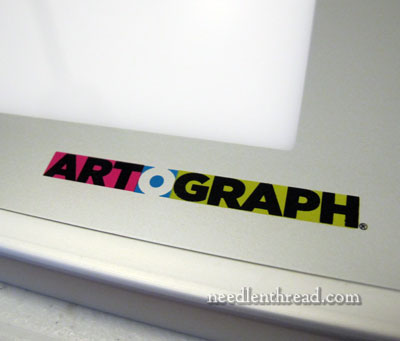
I do a lot of embroidery design transferring and embroidery design drawing. Over the last couple months, for example, I’ve transferred more than 52 monograms onto fabric by tracing. I’ve drawn at least a dozen different monogram combinations, too. Tracing is an essential part of the drawing process, unless I start from scratch every time.
A light box is a great aid to tracing, whether during the design process or during the whole embroidery design transfer process. Sure, there are other ways to transfer an embroidery design, but the quickest way (when it can be managed) is tracing.
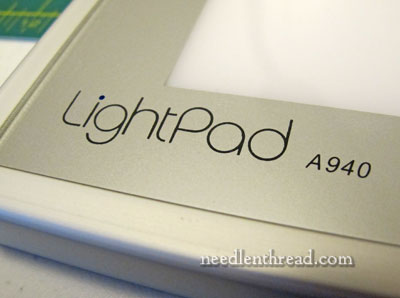
Unfortunately, the little plastic craft light box that I bought years and years ago for a whopping total of $15 doesn’t always do the trick. The aspects that drove me nuts: 1. the lit surface is inconsistent, with the brightest part being right in the middle, and relatively small; 2. the height of the box (about 3″ high) made it awkward to sit and draw at it for any extended period of time; 3. the total surface area is too small – it didn’t accommodate a full 8.5″ x 11″ piece of paper, even turned sideways.
So I tested different “home made” approaches, including a “light table” using plexiglass and a clamp-on utility light. And that worked better, but it has disadvantages, too: 1. It is inconvenient to set up (but ok, I can live with inconvenience); 2. it is hot – the utility light, if it’s on for any extended period of time, lets off a ton of heat; 3. the lit surface is restricted to the area where the utility light is directed, so for larger projects, the design has to be shifted around to get the brightest light underneath it.
I also explored the option of real light tables – the kind you can pull a chair up to as a separate piece of furniture – but they are way out of my budget range and they would take up permanent space. I found one on Craig’s List that was “only” $700, but the footprint was too large (and so was the price tag!). I considered having a real light table made, too, but again, that option was pricey, and there was the whole space consideration.
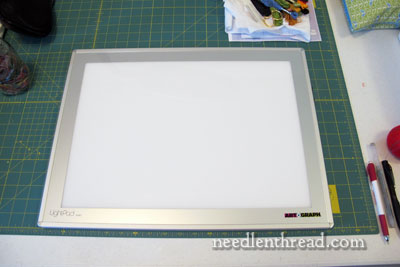
Enter: The LightPad by Art-O-Graph.
Oh, I am in Tracing Heaven! I Love this thing. I’ve enjoyed hours and hours of Sheer Tracing Bliss lately because of it!
The LightPad is a thoroughly wonderful, sturdily constructed, portable light table, without being a table. The lit surface area is huge (and could be huger, as it comes in different sizes), and the lighting behind the glass is LED lighting that lights up the whole lit surface area consistently and brightly.
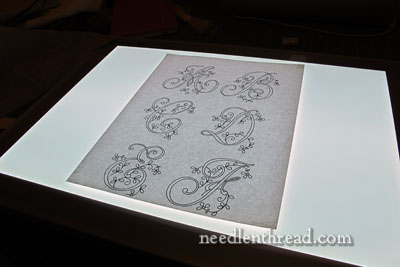
The LightPad I purchased (model A940) has a 12″ x 17″ lighted area, with a whole footprint of 14″ x 19″. It is 5/8″ thick, and sits flat on the surface of the table.
I’ve used it so far to trace patterns onto lightweight, medium, and medium-heavy linens, in white, colors, and natural.
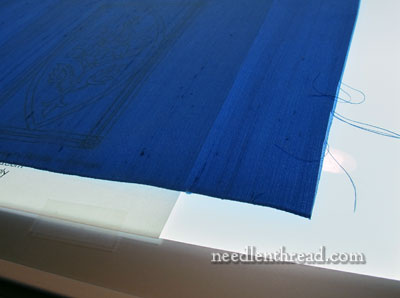
I’ve also used it to trace a pattern onto a deep blue silk.
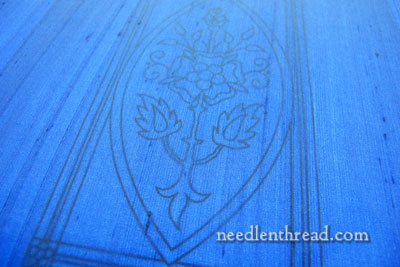
It worked great!
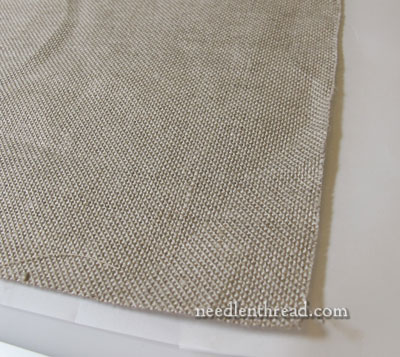
But the most incredible asset of all (for me, anyway!) is the fact that I can trace easily on “natural” colored linen – this oaty-brown color – even when medium-heavy in weight.
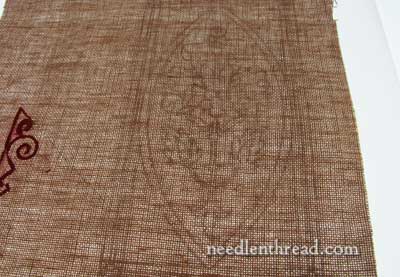
This is a scrap of Montrose 1750 linen, which is relative heavy stuff. It’s an un-ironed scrap laid on top of a pattern on the LightPad to demonstrate that the pattern is visible, even without the linen being stretched and flat over the pattern.
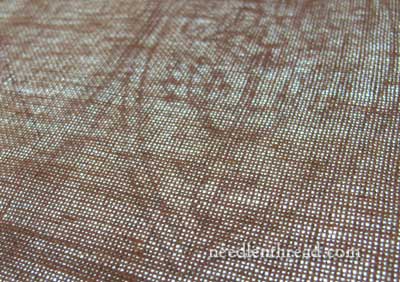
I can definitely see the pattern well enough to trace it easily. And that makes me … giddy!
Like all of the more pricey purchases for the workroom, I budgeted for the LightPad and purchased it as soon as I had saved for it. At first, I was greedy and budgeted for the larger one (17″ x 24″ lit area), but eventually changed my mind and bought the smaller one for less, and sooner.
The LightPad ranks right up there with my floor stand and my embroidery frames now – it’s a Favorite!
Where to Find a LightPad
You can find the Art-O-Graph LightPad in the US through various sources, from art supply stores (Dick Blick carries it, for example), but I got mine through Amazon, which offers it for slightly less than other places, with free shipping.
Since writing this review, I’ve heard from several readers who have purchased different light pads that are lighter, thinner, and less expensive. Here are a couple that have been recommended to me, but I’ve not tried. Look at the specs carefully before purchasing – and it doesn’t hurt to read the reviews, either!
Huion Light Tracer 16 x 12″ (work area) available here on Amazon.
AGPtek – (A3 size work area) available here at Amazon.
If you do a lot of tracing, this is definitely something to add to the birthday / Christmas wish list!
This article contains affiliate links to Amazon, which means that Needle ‘n Thread receives a small commission for purchases made through those links at no extra cost to you. Thanks!







Hi Mary,
I treated myself to a light box similar to yours for Christmas and now would not be without it. It was a little expensive at £100 but it’s A3 size and has good LED lighting. For me, it was money well spent as it saves on all the frustrations that can come about with other forms of transfer. And, it makes transferring really small patterns so much easier. I would highly recommend a light box as part of an embroiderers equipment.
I too am looking for a decent lightbox that is effective but won’t hurt the pocketbook. I am considering the Crayola Light Up Tracing Pad, and wondered if anyone had any experience with it. It is 9×12 which suits my purposes, and uses LED lights, so it seems like it would work. The price is also attractive — about $20 US right now on Amazon.
I have found the flash light app (free) for my IPad works pretty well for smaller projects. I tried the free light box app but found the surface smaller and the tracing action itself sometimes touches the light volume making the light dimmer.
Hello Mary,
I have used an antiquated old rigged box for years and of course the sun through the window when all else fails. This light box is going to be a future investment. With most purchases sometimes it is best to invest in an item you will grow into rather than out of. This is one of them. It was your information on the linen surface that has me interested and the thinness of the box itself. Thanks for sharing your finds. I too would place this as essential as my floor stand and my magnifier light.
Mary, I bought that size first and I LOVE it, as well.
Then I saw that Hobby Lobby has them and I bought the next two smaller sizes. The littlest one fits on my lap for quick things. The same cord fits all the boxes and I leave one plugged in at my sewing table, tucked out of the way and just pull out whichever lightpad I need.
Dear Mary
The art-o-graph light box looks a great embroidery accessory I have a light box for small projects and tracing on a light box does save time, the light-o-graph sounds a really good product and I would love one of these I will have to save up and buy one, another item goes on my wish-list. Thanks so much for sharing this with us.
Regards Anita Simmance
I recently purchased a lightbox, and it really is wonderfully useful, but I’m running into a dilemma. No matter how securely I think I tape my fabric, it always moves when I’m tracing. Does anyone have any suggestions?
Tara, I wonder if it would help to stretch it over a piece of plexiglass? Perhaps with some criss-cross basting stitches across the back to keep it stretched?
I realize having the right size plexiglass might be a challenge, and having the fabric wrapped behind might interfere with seeing the design to trace. Mary will no doubt have just the right solution . . .
Good luck with this and your project!
Best,
Pamela
Northern California
Hi, Tara –
I only tape if I’m working with a really small piece that isn’t likely to shift before I’m finished. Otherwise, pin the fabric to the paper on all sides of the design. That should do it! -MC
Mary,
What a stunning and affordable piece of equipment! As you were describing it I thought it must be at least in the $300 range — but no! And the LED lights are such an improvement over old setups.
Years ago I had a home-made drafting table with a glass insert and light below. I think we used a florescent light. The convenience of the thing was a great blessing. But it took up a whole corner of my room (I used it for publication designs) and was certainly not portable.
Now with your inspiring website I see so many directions I’d love to take with fabric, design, and embroidery. I’m not to the light box stage yet, but am so glad to see it’s there if I progress to that level.
And in the meantime you give us such good examples of brilliant work to emulate. Thanks for a great review!
Best,
Pamela
Northern California
I wanted to share that on your android tablets there is an app called light box. It makes your tablet, well, a light box! 🙂
I don’t know if the iPad has it but I use it for smaller projects. I don’t have a real light box, just an old window glass and a lamp.
Mary, I recently purchased the same light pad and I am in the midst of using it now. It does make the job a breeze, especially at night. Love mine.
I’d been doing the window thing forever, as I’ve not found a good light box. Showed this one to my husband, and he bought it for me immediately! Now to hope it doesn’t break on the way to Moldova.
My life has just been flipped completely on end so there is no room for this in my budget. However I want to inspire those if you who have an AC moore that if they carry this you could use one of their 1/2 off any item coupons and get this for quite a discount! Maybe some of the other craft or art stores have coupons like that too? Also, coupons for AC moore can be used at Michaels and Joann’s and the reverse is true too. HTH
Hello Mary,
This lightpad seems to be very bright. Do you think it would be suitable for linen twill? I don’t have any craftstore nearby to test this kind of fabric.
Thanks.
OMG my prayers answered at last! Tracing onto fabric has always been a stumbling block for me. There are so many embroideries I never did just because I lacked this. I found a used light table which before digital photography was a staple in every photographer’s studio for looking at negatives and slides. It was a bargain at €150 but way too big and high.
Now I will proceed with so much backlogged embroidery work! This is excellent news! Thank you Mary!
By the way, your website looked completely empty for several months, I even sent you a message on FB. I don’t know what the problem was, maybe a browser issue or a virus.
Mary like you I went big. I really do find it is better to work on than my old sloped light box. Mainly the light penetration is better, so does well on the thicker tighter weaves. Bliss. Nearly 12 months now.
There is another good pad but it only comes in the smaller size. Mind you The Triumph LED Light Pad is just one of quite a few now on the market but the triumph is only an A4 which is quite good but transferring chair seats and backs, the larger the better for me.
I tried using the window and sunlight . Well…I got an arm ache and the tape gave way as it melted when the sun came over because I went out for a cup of tea. not happy Jan…
Laying flat it easier to keep a steady continuous line without resting or causing a bleed.
For we Australians I would like to say look around, and check prices. I saw and got my Artograph (because of the size) from a well known Art Shop. A light box/pad(now preferred) is a must. Copying is so much easier for me.
I do like freezer paper with fabric ironed on and run through the printer. But size is limited. Yes Mary the run through printers I have found is definately better than the roller wrap.
I do love Cindy’s in Kansas over kill but one will do me. I made cardboard frames using a bit of bluetack in various sizes to eliminate the overglare.
I use a table always so no lap tracing for me.
Each to their own.
Thanks Mary for talking about lights and other helpful hints.
Cheers all
Thank you for this review Mary. I’ve been coveting one of these for a couple of years and your review put me over the edge. It came yesterday and I love it!
Hi Mary, I hope you are going to comment on pens or whatever you use to trace. I am aware of a blue felt tip pen which washes out, but it wouldn’t work for fine design lines. You’ve defiantly got me interested in a light pad.
You “light” up my life Mary…thank you for the light info. Jo
Do you think the Light Pad would work for black fabrics which are somewhat transparent? (My fabric is probably as transparent as the blue piece of silk you are showing, except it is black).
How do you keep your fabric smooth and flat on the light board? I have one and I’ve been using double sided tape but I didn’t know if you had a different solution.
Double sided tape is probably not a great idea, because it can residue (on your light pad and on your fabric). I iron my fabric well, first, making sure it is absolutely wrinkle free. Then, if the fabric is small (fits within the size of the light pad), I tape my pattern down using Scotch tape and then I tape my fabric on top of it, also using Scotch tape. If the fabric is larger than the light pad, I pin it to the paper pattern that’s been taped to the light pad.
Hello, Thank you for this info. The book I bought, THREAD FOLK, byLibby Moore, has neat pattern pages, but they are so thick! I think the light box idea will work. Also, could you please tell me which stand and what fame you use/recommend. Thank you.
Your link above to the AGPtek – (9 x 12.5″ work area), is not for the light board/box.
Thanks! Fixed it!
There is an iPad app called Light Box Trace that is handy, especially if you have an iPad Pro which has a larger screen. It has a gray or white background which are very uniform across the iPad screen and it has a “lock” to keep it from sliding off your screen as you trace across the image or manipulate your fabric. You can also use it for photos or images that you have in your photo library or clipboard, so you can use it for more than images that you already put on a piece of paper. Best yet, I think it is still a free app!
Sounds like a handy app! Unfortunately, PDFs are not constrained to display images at a specific “actual size,” so if you go this route, make sure to measure the traceable items when the screen is locked, to ensure the transfer size is accurate.